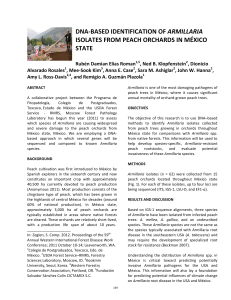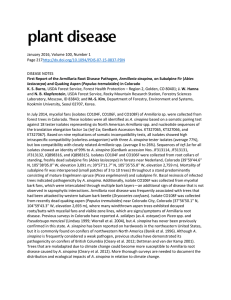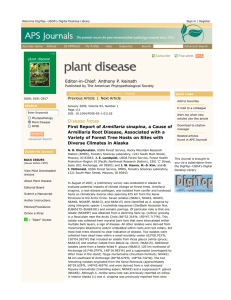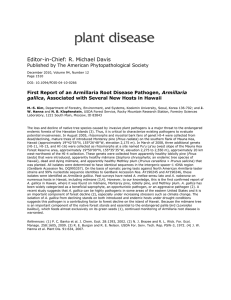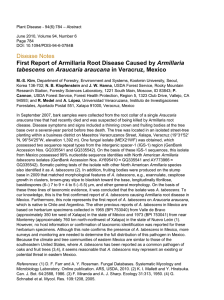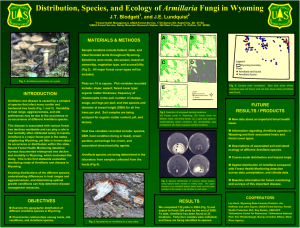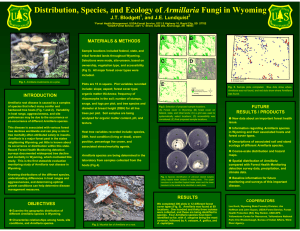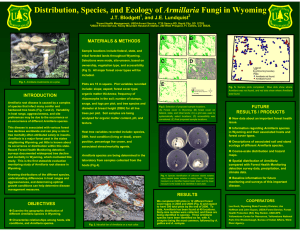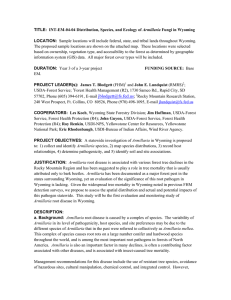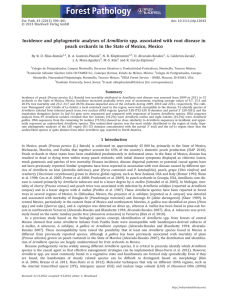ARMILLARIA PRUNUS PERSICA
advertisement
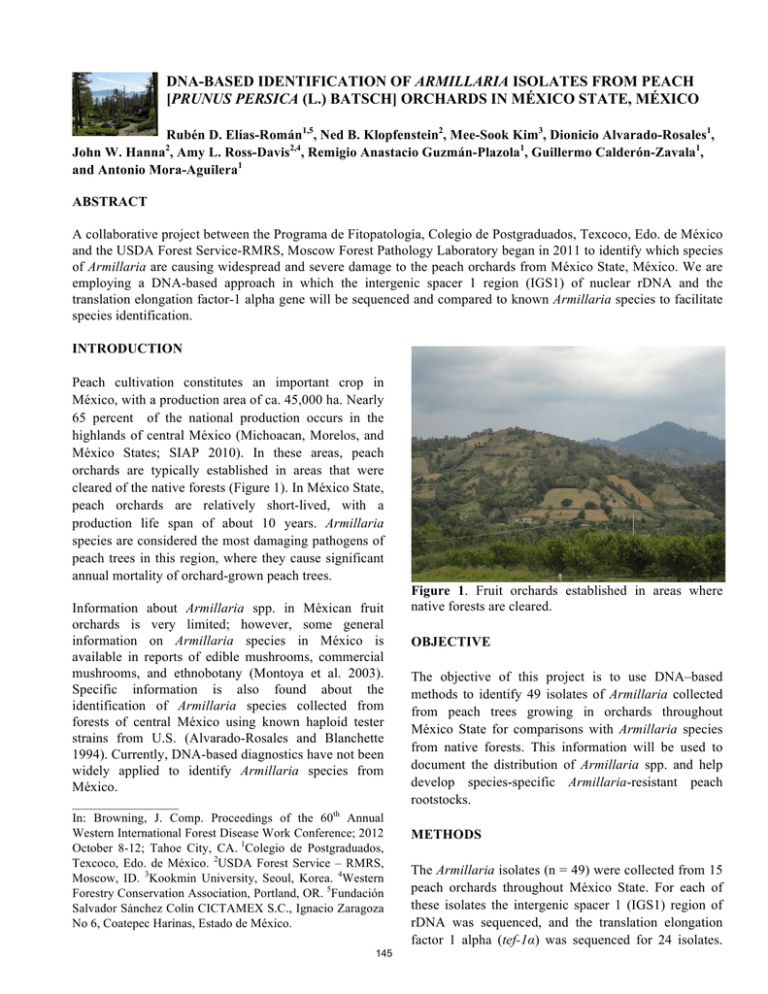
DNA-BASED IDENTIFICATION OF ARMILLARIA ISOLATES FROM PEACH [PRUNUS PERSICA (L.) BATSCH] ORCHARDS IN MÉXICO STATE, MÉXICO Rubén D. Elías-Román1,5, Ned B. Klopfenstein2, Mee-Sook Kim3, Dionicio Alvarado-Rosales1, John W. Hanna2, Amy L. Ross-Davis2,4, Remigio Anastacio Guzmán-Plazola1, Guillermo Calderón-Zavala1, and Antonio Mora-Aguilera1 ABSTRACT A collaborative project between the Programa de Fitopatología, Colegio de Postgraduados, Texcoco, Edo. de México and the USDA Forest Service-RMRS, Moscow Forest Pathology Laboratory began in 2011 to identify which species of Armillaria are causing widespread and severe damage to the peach orchards from México State, México. We are employing a DNA-based approach in which the intergenic spacer 1 region (IGS1) of nuclear rDNA and the translation elongation factor-1 alpha gene will be sequenced and compared to known Armillaria species to facilitate species identification. INTRODUCTION Peach cultivation constitutes an important crop in México, with a production area of ca. 45,000 ha. Nearly 65 percent of the national production occurs in the highlands of central México (Michoacan, Morelos, and México States; SIAP 2010). In these areas, peach orchards are typically established in areas that were cleared of the native forests (Figure 1). In México State, peach orchards are relatively short-lived, with a production life span of about 10 years. Armillaria species are considered the most damaging pathogens of peach trees in this region, where they cause significant annual mortality of orchard-grown peach trees. Information about Armillaria spp. in Méxican fruit orchards is very limited; however, some general information on Armillaria species in México is available in reports of edible mushrooms, commercial mushrooms, and ethnobotany (Montoya et al. 2003). Specific information is also found about the identification of Armillaria species collected from forests of central México using known haploid tester strains from U.S. (Alvarado-Rosales and Blanchette 1994). Currently, DNA-based diagnostics have not been widely applied to identify Armillaria species from México. _________________ In: Browning, J. Comp. Proceedings of the 60th Annual Western International Forest Disease Work Conference; 2012 October 8-12; Tahoe City, CA. 1Colegio de Postgraduados, Texcoco, Edo. de México. 2USDA Forest Service – RMRS, Moscow, ID. 3Kookmin University, Seoul, Korea. 4Western Forestry Conservation Association, Portland, OR. 5Fundación Salvador Sánchez Colín CICTAMEX S.C., Ignacio Zaragoza No 6, Coatepec Harinas, Estado de México. 145 Figure 1. Fruit orchards established in areas where native forests are cleared. OBJECTIVE The objective of this project is to use DNA–based methods to identify 49 isolates of Armillaria collected from peach trees growing in orchards throughout México State for comparisons with Armillaria species from native forests. This information will be used to document the distribution of Armillaria spp. and help develop species-specific Armillaria-resistant peach rootstocks. METHODS The Armillaria isolates (n = 49) were collected from 15 peach orchards throughout México State. For each of these isolates the intergenic spacer 1 (IGS1) region of rDNA was sequenced, and the translation elongation factor 1 alpha (tef-1α) was sequenced for 24 isolates. The protocol of Kim et al. (2006) was used for PCR amplification of IGS1. Template DNA used for tef-1α PCR was obtained by the protocol of Zhang et al. (2010). PCR was performed using the methods of RossDavis et al. (2012) except that primers were replaced by ARMEFF (5 ft. CGT GAY TTY ATC AAG AAC ATG AT 3 ft.) and ARMEFR (5 ft. TAC CCG TTC GGC GAT CAA TCT 3 ft.) designed by J.W. Hanna (USDA Forest Service, RMRS). PCR products were sequenced on an ABI3730xl DNA Analyzer (Applied Biosystems, Foster City, CA, U.S.) at the University of Wisconsin Biotechnology Center (Madison, WI, U.S.). The sequences were ed. with BioEdit (ver. 7.1.3; Ibis Biosciences, Inc.). For phylogenetic analysis, parsimony analyses were performed with PAUP (4.0b10) to determine phylogenetic relationships among representative Armillaria isolates from species found in Méxican peach orchards and the other North American Armillaria species based on tef-1α sequence. Figure 2. A 50 percent majority-rule bootstrap-consensus tree from the parsimony analysis of the translation elongation factor 1-alpha gene (tef-1α). Bootstrap supports are indicated above branches based on 1000 bootstrap replicates. 146 RESULTS AND DISCUSSION Based on IGS1 sequences, all Armillaria isolates from infected peach trees could be assigned to three different taxa: Five of the 49 isolates were classified as A. mellea, eight isolates belonged to a single clade within the A. gallica complex, and the remaining 36 isolates were similar to each other, but distinct from other Armillaria species for which IGS1 sequences were available. Parsimony analysis of tef-1α sequences revealed the presence the A. mellea, A. gallica, and a unique clade that likely represents an undescribed species (Figure 2). Understanding the distribution of Armillaria species in México is also critical to predict potentially invasive Armillaria species for other States in México. This information also lays a foundation for predicting potential influences of climate change on Armillaria root disease. REFERENCES Alvarado-Rosales, D.; Blanchette, R.A. 1994. Armillaria species from forests of central Mexico. Phytopathology. 84:1106. Kim, M.-S.; Klopfenstein, N.B.; Hanna, J.W.; McDonald, G.I. 2006. Characterization of North American Armillaria species: genetic relationships determined by ribosomal DNA sequences and AFLP markers. Forest Pathology. 36:145-164. Montoya, A.; Hernandez-Totomoch, O.; Estrada-Torres, A. and others. 2003. Traditional knowledge about mushrooms in a Nahua community in the state of Tlaxcala, Mexico. Mycologia. 95:793-806. Ross-Davis, A.L.; Hanna, J.W.; Kim, M.-S.; Klopfenstein, N.B. 2012. Advances toward DNA-based identification and phylogeny of North American Armillaria species using elongation factor-1 alpha gene. Mycoscience. 53:161-165. Figure 3. Mushrooms (basidiomata) of an undescribed Armillaria species frequently isolated from infected peach trees in México State. Schnabel, G.; Ash, J.S.; Bryson, P.K. 2005. Identification and characterization of Armillaria tabescens from the southeastern United States. Mycological Research. 109:1208-1222. The undescribed Armillaria sp. (Figure 3) is quite distinct from species typically found in association with Armillaria root disease of peach trees in the southeastern U.S. (A. tabescens) and México (A. gallica). Work is underway to formally describe this undescribed Armillaria species. Because this undescribed Armillaria sp. is quite damaging to peach production, it is important to document its distribution so appropriate disease management practices can be implemented. In addition, the development of specialized rootstock is perhaps required for resistance to this undetermined Armillaria sp. (Schnabel et al. 2005). SIAP 2010. www.siap.gob.mx/index.php/agricultura/produccionanual/cierre-de-la-produccion-agricola-por-cultivo.html. 147 Zhang, Y.J.; Zhang, S.; Liu, X.Z. and others. 2010. A simple method of genomic DNA extraction suitable for analysis of bulk fungal strains. Letters in Applied Microbiology. 51:114-118.
